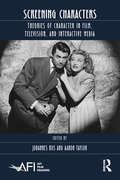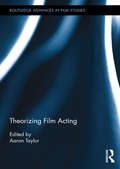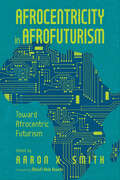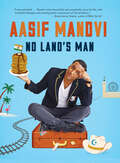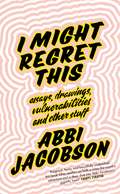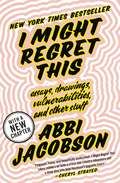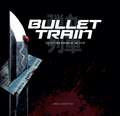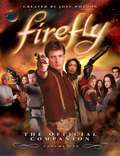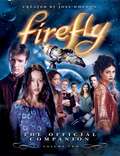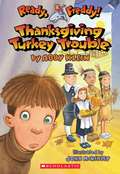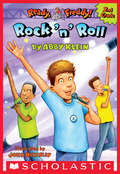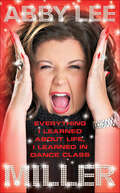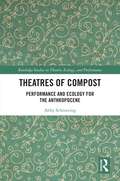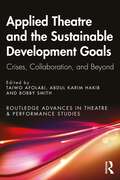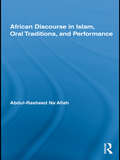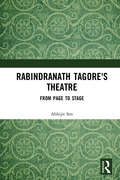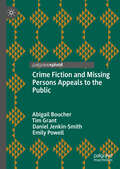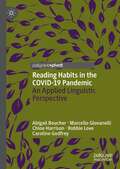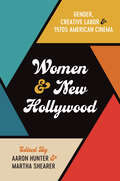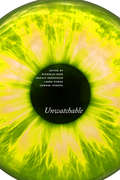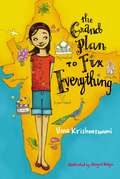- Table View
- List View
Screening Characters: Theories of Character in Film, Television, and Interactive Media (AFI Film Readers)
by Johannes Riis Aaron TaylorCharacters are central to our experiences of screened fictions and invite a host of questions. The contributors to Screening Characters draw on archival material, interviews, philosophical inquiry, and conceptual analysis in order to give new, thought-provoking answers to these queries. Providing multifaceted accounts of the nature of screen characters, contributions are organized around a series of important subjects, including issues of class, race, ethics, and generic types as they are encountered in moving image media. These topics, in turn, are personified by such memorable figures as Cary Grant, Jon Hamm, Audrey Hepburn, and Seul-gi Kim, in addition to avatars, online personalities, animated characters, and the ensembles of shows such as The Sopranos, Mad Men, and Breaking Bad.
Theorizing Film Acting (Routledge Advances in Film Studies)
by Aaron TaylorThis comprehensive collection provides theoretical accounts of the grounds and phenomenon of film acting. The volume features entries by some of the most prominent scholars on film acting who collectively represent the various theoretical traditions that constitute the discipline of film studies. Each section proposes novel ways of considering the recurring motifs in academic enquiries into film acting, including: (1) the mutually contingent problematic of description and interpretation, (2) the intricacies of bodily dynamics and their reception by audiences, (3) the significance of star performance, and (4) the impact of evolving technologies and film styles on acting traditions.
Afrocentricity in AfroFuturism: Toward Afrocentric Futurism
by Aaron X. SmithContributions by Taharka Adé, Molefi Kete Asante, Alonge O. Clarkson, John P. Craig, Ifetayo M. Flannery, Kofi Kubatanna, Lehasa Moloi, M. Ndiika Mutere, and Aaron X. SmithIn the twenty-first century, AfroFuturism—a historical and philosophical concept of the future imagined through a Black cultural lens—has been interpreted through a myriad of writers, artists, scientists, and other visionary creatives. In Afrocentricity in AfroFuturism: Toward Afrocentric Futurism, editor Aaron X. Smith curates a collection of interdisciplinary essays that critiques existing scholarship on Black futurity. In contrast to much previous work, these essays ground their explorations in African agency, centering the African within historical and cultural reality. Situating Afrocentricity as the field’s foundational root and springboard for an expansive future, contributors detail potential new modes of existence and expression for African people throughout the diaspora.Divided into two parts—Representations and Transformations—this book examines the tensions created by historical and cultural dislocation of African peoples and consciousness. Contributors cover varied topics such as the intersections of culture and design; techno culture; neuroscience; and the multiplicity of African cultural influences in aesthetics, oratory, visual art, hip hop, and more. Essays range from theoretical analyses to close readings of history and popular culture, from the Haitian Revolution to Sun Ra, Janelle Monáe’s Dirty Computer, and Black Panther. Afrocentricity in AfroFuturism offers an expansive vision of AfroFuturism and its ranging significance to contemporary culture and discourse.
No Land's Man
by Aasif MandviThe actor shares a heartfelt “collection of humorous essays that explore his myriad identities: Indian, Muslim, British, and American” (The Boston Globe).“My father moved our family to the United States because of a word. It was a word whose meaning fascinated him. It was a singularly American word, a fat word, a word that could only be spoken with decadent pride. That word was . . . Brunch! “The beauty of America,” he would say, “is they have so much food, that between breakfast and lunch they have to stop and eat again.”“—from “International House of Patel”If you’re an Indo-Muslim-British-American actor who has spent more time in bars than mosques over the past few decades, turns out it’s a little tough to explain who you are or where you are from. In No Land’s Man Aasif Mandvi explores this and other conundrums through stories about his family, ambition, desire, and culture that range from dealing with his brunch-obsessed father, to being a high-school-age Michael Jackson impersonator, to joining a Bible study group in order to seduce a nice Christian girl, to improbably becoming America’s favorite Muslim/Indian/Arab/Brown/Doctor correspondent on The Daily Show with Jon Stewart.This is a book filled with passion, discovery, and humor. Mandvi hilariously and poignantly describes a journey that will resonate with anyone who has had to navigate his or her way in the murky space between lands. Or anyone who really loves brunch.“Best Comedy Books of 2014” selection by The Washington PostPraise for No Land’s Man“I was enthralled . . . . Mandvi writes beautifully and comedically about his life, with wonderful dialogue and revealing detail, reminiscent of David Sedaris.” —Jonathan Ames, author of Wake Up, Sir!“It always bothered me that Aasif was more than merely funny—he’s also a great actor. Now I’ve learned he’s an amazing storyteller as well, and I am furious . . . but also grateful. Aasif’s movement between cultures and genres is what makes him and his story singularly funny, poignant, and essential.” —John Hodgman, author of The Areas of My Expertise and More Information Than You Require“Aasif is my favorite Indo-Muslim-British-American Daily Show correspondent ever. I loved No Land’s Man!” —Jim Gaffigan, author of Dad Is Fat and Food: A Love Story“A lighthearted but heartfelt portrait of Mandvi’s childhood and his struggles to come to terms with his rather complicated life.” —The Boston Globe
Final Cut Studio On the Spot: The Independent Studio Handbook
by Richard Harrington Abba Shapiro Robbie CarmanPacked with more than 500 techniques, this book delivers what you need to know-on the spot. It is suited to editors of all experience levels, whether you are:* Migrating from another NLE* Upgrading to Final Cut Studio 2* Seeking a handy reference to raise your proficiencyNo need to wade through tomes of documentation. Final Cut Studio On the Spot presents immediate solutions in an accessible format. Step-by-step instruction by Apple Certified Pros shows you how to:* Optimize system performance* Create impressive titles with Generators, Motion, LiveType, and Photoshop* Build Commercial-quality transitions* Work quickly with buttons and keyboard shortcuts* Color correct to save vital shots, and keep them broadcast legal* Fix and mix for professional-quality audio* Use the compositing tools of master editors* Design and import graphics seamlessly* Integrate with other applications including Motion, Soundtrack Pro and Color* Troubleshoot and recover files* Manage media and backup strategies* Export and publish finished projects to tape, DVD, or the Web
I Might Regret This: Essays, Drawings, Vulnerabilities and Other Stuff
by Abbi JacobsonA NEW YORK TIMES BESTSELLERFrom the co-creator and co-star of the hit series Broad City, a hilarious and poignant collection about love, loss, work, comedy and figuring out who you really are when you thought you already knew.When Abbi Jacobson announced to friends and acquaintances that she planned to drive across the country alone, she was met with lots of questions and opinions: Why wasn't she going with friends? Wouldn't it be incredibly lonely? The North route is better! Was it safe for a woman? The Southern route is the way to go! You should bring mace! And a common one . . . why? But Abbi had always found comfort in solitude, and needed space to step back and hit the reset button. As she spent time in each city and town on her way to Los Angeles, she mulled over the big questions - What do I really want? What is the worst possible scenario in which I could run into my ex? How has the decision to wear my shirts tucked in been pivotal in my adulthood? In this collection of anecdotes, observations and reflections - all told in the sharp, wildly funny and relatable voice that has endeared Abbi to critics and fans alike - readers will feel like they're in the passenger seat on a fun and, ultimately, inspiring journey. With some original illustrations by the author.
I Might Regret This: Essays, Drawings, Vulnerabilities, and Other Stuff
by Abbi JacobsonFrom the co-creator and co-star of the hit series Broad City, a "poignant, funny, and beautifully unabashed" (Cheryl Strayed) essay collection about love, loss, work, comedy, and figuring out who you really are when you thought you already knew. <P><P>When Abbi Jacobson announced to friends and acquaintances that she planned to drive across the country alone, she was met with lots of questions and opinions: Why wasn't she going with friends? Wouldn't it be incredibly lonely? The North route is better! Was it safe for a woman? The Southern route is the way to go! You should bring mace! And a common one... why? <P><P>But Abbi had always found comfort in solitude, and needed space to step back and hit the reset button. As she spent time in each city and town on her way to Los Angeles, she mulled over the big questions-- What do I really want? What is the worst possible scenario in which I could run into my ex? How has the decision to wear my shirts tucked in been pivotal in my adulthood? <P><P>In this collection of anecdotes, observations and reflections--all told in the sharp, wildly funny, and relatable voice that has endeared Abbi to critics and fans alike--readers will feel like they're in the passenger seat on a fun and, ultimately, inspiring journey. With some original illustrations by the author. <P><b>A New York Times Bestseller</b>
Bullet Train: The Art and Making of the Film
by Abbie BernsteinThe official companion to the film Bullet Train from Deadpool 2 and Fast & Furious Presents: Hobbs & Shaw director David Leitch, starring Brad Pitt. Screenplay by Zak Olkewicz.Assassin-for-hire Ladybug (Brad Pitt) is filling in for a colleague and just wants an easy in-and-out mission for once. What he gets is far from it. There are four other assassins on this Japanese bullet train (Joey King, Brian Tyree Henry, Aaron Taylor-Johnson, and Zazie Beetz) and when each assassin&’s mission impedes the others&’, it leads to disastrous consequences. Go behind the scenes of this action-packed film in exclusive detail. This beautiful coffee-table book is full to the brim with concept art, behind-the-scenes photography, and storyboards, accompanied by exclusive interviews with the cast and crew, including David Leitch, Aaron Taylor-Johnson, Brian Tyree Henry, and Hiroyuki Sanada.
Firefly: The Official Companion, Volume One
by Joss Whedon Abbie BernsteinBefore the smash hit movie Serenity came Firefly, the cult TV series which started it all and became a DVD phenomenon, selling almost half a million copies. Set 500 years in the future, Firefly centers around Mal Reynolds, captain of the ship-for-hire Serenity and its eclectic crew of galactic misfits. When he takes on two passengers, a young doctor and his mysterious, telepathic sister, he gets much more than he bargained for... This official companion is just what the show's fervent fans, the `Browncoats', have been waiting for, with unseen photos, scripts, behind the scenes secrets, and exclusive input from the cast and crew, including of course creator Joss Whedon.
Firefly: The Official Companion, Volume Two
by Joss Whedon Abbie BernsteinBefore the smash hit movie Serenity came Firefly, the cult TV series which started it all and became a DVD phenomenon, selling almost half a million copies. Set 500 years in the future, Firefly centers around Mal Reynolds, captain of the ship-for-hire Serenity and its eclectic crew of galactic misfits. When he takes on two passengers, a young doctor and his mysterious, telepathic sister, he gets much more than he bargained for. This official companion is just what the show's fervent fans, the 'Browncoats', have been waiting for, with unseen photos, scripts, behind the scenes secrets, and exclusive input from the cast and crew, including of course creator Joss Whedon. Contains the second part of an extended interview with Joss Whedon, as well as exclusive new interviews with the cast, executive producer Tim Minear and many other writers and crew members; the full, uncut shooting scripts for 'Jaynestown', 'Out of Gas', 'Ariel', 'War Stories' 'Trash', 'The Message', 'Heart of Gold' and 'Objects in Space', annotated with memories from the cast and crew; extended behind-the-scenes interviews with the crew behind Firefly, including sections on the production design and visual effects, illustrated with unseen imagery; in addition a section on the Firefly fans and of course Vera...
LEGO Build Yourself Happy: The Joy of LEGO play
by Abbie HeadonRelease your inner child and build yourself happy with LEGO® bricks.Are you failing to find inner peace on a yoga mat? Does life feel like all work and no play?Having fun and getting creative can boost your mood and your well-being. So if you're looking for ways to unwind and make time for yourself, then let this book guide you on a LEGO® brick road to happiness.With more than 50 mindful LEGO building activities, discover how you can find balance, connect with friends and family, relax and improve your sleep habits.©2019 The LEGO Group.
Ready, Freddy! Thanksgiving Turkey Trouble (Ready, Freddy! #(#15))
by Abby KleinWould you believe being a turkey for the first grade Thanksgiving play will get Freddy locked up in jail? Freddy believes it. In fact he believes all kinds of terrible things will happen if he has to dress up as a turkey for the play. <P><P> At school there's teasing, bullying, copy-catting, tattling, joking, arguments, laughing, time-outs and all kinds of kid and teacher stuff you've had in your own school. At home, there's teasing from Freddy's sister and understanding from his mom, but they don't help him get over having to be the turkey. <P><P>Finally, just in time, Freddy learns a trick that will make being a turkey fun! At the end of the story are some ideas for Thanksgiving crafts.
Rock'n'Roll (Ready, Freddy! 2nd Grade #8)
by Abby Klein John MckinleyFreddy's favorite band is having a contest -- make a video of their new song and win tickets and backstage passes to the concert! There's going to be so much competition, though. Freddy definitely needs help from his friends, and maybe even ... his sister?
Everything I Learned About Life, I Learned in Dance Class
by Abby Lee MillerStraight-talking advice on success from the choreographer, instructor, and star of Dance Moms.Ultimate “Tiger Mom” Abby Lee Miller—the passionate, unapologetically outspoken, tough-as-nails star of Lifetime’s phenomenal hit Dance Moms and Abby’s Ultimate Dance Competition—offers inspirational, tough love guidance for parents who want to help their children succeed and for readers of all ages striving to become the best they can be. If you want to help your kid reach the top, you can find no better coach than Abby. While some may criticize her methods, no one argues with her results. Her kids excel, her teams win, and her alumni go on to Broadway careers.Organized by “Abbyisms,” her unique and effective philosophies on hard work, competition, and life, this straight-talking guide provides clear and proven advice for achieving success, from figuring out your child’s passion to laying the groundwork for an exciting future career. Abby answers tough questions from real moms, shares all the stories fans want to hear, and includes vignettes from shining alums who give their take on her unique approach and how it helped them make their dreams come true.
Theatres of Compost: Performance and Ecology for the Anthropocene (Routledge Studies in Theatre, Ecology, and Performance)
by Abby SchroeringTheatres of Compost places ecology at the center of performance scholarship and criticism, and it positions performance as a key cultural process for bringing about a more just and sustainable future.Examining a unique archive of agricultural performances—plays, theatre collectives, and activist rituals that engage questions of how humans use the land and produce food—this book lays out a framework for how theatre and performance contribute to a cultural shift toward ecological awareness. Theatre of compost is performance that directly engages ideologies of exploitation, mass production, and accumulation. Instead of discarding the forms, themes, methodologies, and histories that have perpetuated ecological destruction, the case studies in this book show that what has come before can be composted: broken down and reconstituted as the fertile foundation for a more livable life in the Anthropocene. Theatres of Compost will appeal to the new but quickly growing subfield of performance and ecology. As the climate and ecological crises worsen, more scholars and students in theatre and performance will be searching for ways to make their work meaningful and relevant.This book will be a helpful resource for graduate-level courses in performance studies, performance and ecology, and the environmental humanities.
Applied Theatre and the Sustainable Development Goals: Crises, Collaboration, and Beyond (ISSN)
by Bobby Smith Taiwo Afolabi Abdul Karim HakibThis book is the first definitive publication to consider the intersections of applied theatre and the Sustainable Development Goals (SDGs) – a series of goals which have shaped development and social justice initiatives from 2015 to 2030.It brings together emerging and leading scholars and practitioners engaged in creative and community contexts globally. In so doing, the book offers critical insights to explore the convergences, complexities, and tensions of working within development frameworks, through theatre. Divided into three thematic areas, it maps out the ways in which applied theatre has related to the SDGs, examines issues with global collaborations, and, as 2030 approaches and the SDG era draws to a close, interrogates such practices, envisioning what the role of applied theatre might be in the post-SDG era. The book provokes reflection about this specific era of applied theatre and global development, as well as discussion regarding what comes next.This volume will be of importance to students, artists, scholars, practitioners, and policymakers working in applied theatre and the field of development.
African Discourse in Islam, Oral Traditions, and Performance (African Studies)
by Abdul-Rasheed Na'AllahThrough an engaged analysis of writers such as Wole Soyinka, Ola Rotimi, Niyi Osundare, and Tanure Ojaide and of African traditional oral poets like Omoekee Amao Ilorin and Mamman Shata Katsina, Abdul-Rasheed Na'Allah develops an African indigenous discourse paradigm for interpreting and understanding literary and cultural materials. Na'Allah argues for the need for cultural diversity in critical theorizing in the twenty-first century. He highlights the critical issues facing scholars and students involved in criticism and translation of marginalized texts. By returning the African knowledge system back to its roots and placing it side by side with Western paradigms, Na'Allah has produced a text that will be required reading for scholars and students of African culture and literature. It is an important contribution to scholarship in the domain of mobility of African oral tradition, and on African literary, cultural and performance discourse.
Rabindranath Tagore's Theatre: From Page to Stage
by Abhijit SenThis book analyses Rabindranath Tagore’s contribution to Bengali drama and theatre. Throughout this book, Abhijit Sen locates and studies Rabindranath’s experiments with drama/theatre in the context of the theatre available in nineteenth-century Bengal, and explores the innovative strategies he adopted to promote his ‘brand’ of theatre. This approach finds validation in the fact that Rabindranath combined in himself the roles of author-actor-producer, who always felt that, without performance, his dramatic compositions fell short of the desired completeness. Various facets of his plays as theatre and his own role as a theatre-practitioner are the prime focus of this book. This book will be of great interest to students and scholars in Theatre and Performance Studies and most notably, those focusing on Indian Theatre and Postcolonial Theatre.
Crime Fiction and Missing Persons Appeals to the Public
by Tim Grant Emily Powell Abigail Boucher Daniel Jenkin-SmithThis book draws upon genre fiction studies, forensic linguistics, and media studies to investigate the overlap between crime fiction conventions and the writing of missing persons appeals to the public. This book is based on a pilot project funded by the Aston Institute for Forensic Linguistics, entitled 'Genre, Pacing, and Narrative in Police Missing Persons Appeals' (Aug 2021-Nov 2022). The authors identify a missing persons appeal as a literary and linguistic genre in its own right and illustrate the problems that arise when the appeals writing process goes unregulated or unstudied: there is currently little-to-no official, national police guidance, regulation, or standard procedure for writing a missing persons appeal in the UK. The authors also identify opportunities for improving the writing and delivery of appeals by further (and more intentionally) applying crime fiction conventions, narrative devices, and pacing, to maximise audience reach and increase the chances of recovering a missing person. This book will be of particular interest to genre fiction scholars (particularly those interested in crime fiction), forensic linguists, and media studies scholars.
Reading Habits in the COVID-19 Pandemic: An Applied Linguistic Perspective
by Marcello Giovanelli Robbie Love Chloe Harrison Abigail Boucher Caroline GodfreyThis book presents and analyses the results of the Lockdown Library Project survey, using a range of quantitative and qualitative approaches to provide a unique insight into the ways in which the first UK COVID-19 lockdown affected public reading habits. The authors begin by outlining the background to the study, the research methodology and design, and an overview of the headlines of the data, before going on to survey the literature on the relationship between pandemics, literature (especially the role played by genre and popular fiction) and reading habits. They then examine how participants reported that the lockdown period had affected the amount that they read; how they accessed books and discussed their reading with others; the use of reading as a coping strategy; and returning to re-read books that offered familiarity, reliability, and nostalgia. Finally, the concluding chapter brings together the overall findings of the project and briefly outlines future work in the field. This book will be of interest to academics in fields such as literary and genre studies, applied linguistics, corpus linguistics, stylistics, health humanities, and sociology, as well as practitioners working in education, in bibliotherapy, and in libraries.
Women and New Hollywood: Gender, Creative Labor, and 1970s American Cinema
by James Morrison Amelie Hastie Karen Pearlman Oliver Gruner Nicholas Godfrey Anna Backman Rogers Maria Pramaggiore Maya Montañez Smukler Alicia Kozma Nicholas Forster Abigail Cheever Virginia Bonner Adrian GarveyThe 1970s has often been hailed as a great moment for American film, as a generation of “New Hollywood” directors like Scorsese, Coppola, and Altman offered idiosyncratic visions of what movies could be. Yet the auteurist discourse hailing these directors as the sole authors of their films has obscured the important creative roles women played in the 1970s American film industry. Women and New Hollywood revises our understanding of this important era in American film by examining the contributions that women made not only as directors, but also as screenwriters, editors, actors, producers, and critics. Including essays on film history, film texts, and the decade’s film theory and criticism, this collection showcases the rich and varied cinematic products of women’s creative labor, as well as the considerable barriers they faced. It considers both women working within and beyond the Hollywood film industry, reconceptualizing New Hollywood by bringing it into dialogue with other American cinemas of the 1970s. By valuing the many forms of creative labor involved in film production, this collection offers exciting alternatives to the auteurist model and new ways of appreciating the themes and aesthetics of 1970s American film.
Techno-Orientalism
by Jinny Huh Catherine Fung Abigail De Kosnik Seo-Young Chu Dylan Yeats Kathryn Allan Julie Ha Tran Aimee Bahng Jason Crum Tzarina T. Prater Douglas S. Ishii Greta A. Niu Kenneth Hough Betsy Huang Se Young Kim Warren Liu Victor Bascara David S. Roh Steve Choe Charles ParkWhat will the future look like? To judge from many speculative fiction films and books, from Blade Runner to Cloud Atlas, the future will be full of cities that resemble Tokyo, Hong Kong, and Shanghai, and it will be populated mainly by cold, unfeeling citizens who act like robots. Techno-Orientalism investigates the phenomenon of imagining Asia and Asians in hypo- or hyper-technological terms in literary, cinematic, and new media representations, while critically examining the stereotype of Asians as both technologically advanced and intellectually primitive, in dire need of Western consciousness-raising. The collection's fourteen original essays trace the discourse of techno-orientalism across a wide array of media, from radio serials to cyberpunk novels, from Sax Rohmer's Dr. Fu Manchu to Firefly. Applying a variety of theoretical, historical, and interpretive approaches, the contributors consider techno-orientalism a truly global phenomenon. In part, they tackle the key question of how these stereotypes serve to both express and assuage Western anxieties about Asia's growing cultural influence and economic dominance. Yet the book also examines artists who have appropriated techno-orientalist tropes in order to critique racist and imperialist attitudes. Techno-Orientalism is the first collection to define and critically analyze a phenomenon that pervades both science fiction and real-world news coverage of Asia. With essays on subjects ranging from wartime rhetoric of race and technology to science fiction by contemporary Asian American writers to the cultural implications of Korean gamers, this volume offers innovative perspectives and broadens conventional discussions in Asian American Cultural studies.
Unwatchable
by J. Hoberman Jonathan Rosenbaum Boris Groys Susie Bright Vivian Sobchack W.J.T. Mitchell Noel Carroll Bill Nichols Jonathan Crary Stefano Harney Jan Olsson Barbara Hammer B. Ruby Rich Fred Moten Mattias Frey Abigail De Kosnik E. Ann Kaplan Jeffrey Sconce Meghan Sutherland Michael Boyce Gillespie Christophe Wall-Romana Jennifer Malkowski Asbjørn Grønstad Jack Halberstam Jared Sexton Rebecca Schneider Frances Guerin Peter Geimer Alexandra Juhasz Julian Hanich Samuel England Mauro Resmini Katariina Kyrölä Erika Balsom Kenneth Berger Alex Bush Alec Butler Mel Chen Lynne Joyrich Nathan Lee Akira Lippit Brandy Monk-Payton Danielle Peers Raul Perez Elif Rongen-Kaynakçi Philipp Stiasny Bennet Togler Leshu Torchin Alok Vaid-Menon Meir Wigoder Emily Wills Federico Windhausen Stanley Wolukau-Wanambwa Genevieve Yue Alenka Zupancic Poulomi SahaWe all have images that we find unwatchable, whether for ethical, political, or sensory and affective reasons. From news coverage of terror attacks to viral videos of police brutality, and from graphic horror films to transgressive artworks, many of the images in our media culture might strike us as unsuitable for viewing. Yet what does it mean to proclaim something “unwatchable”: disturbing, revolting, poor, tedious, or literally inaccessible? With over 50 original essays by leading scholars, artists, critics, and curators, this is the first book to trace the “unwatchable” across our contemporary media environment, in which viewers encounter difficult content on various screens and platforms. Appealing to a broad academic and general readership, the volume offers multidisciplinary approaches to the vast array of troubling images that circulate in global visual culture.
The Grand Plan to Fix Everything
by Uma Krishnaswami Abigail HalpinEleven-year old Dini loves movies--watching them, reading about them, trying to write her own--especially Bollywood movies. But when her mother tells her some big news, it does not at all jive with the script of her life she has in mind. Her family is moving to India...and, not even to Bombay, which is the center of the Bollywood universe and home to Dini's all-time most favorite star, Dolly. No, Dini is moving to a teeny, tiny village she can't even find on a map. Swapnagiri. It means Dream Mountain and it only looks like a word that's hard to pronounce. But to that open-minded person who sounds the name out, one letter at a time, it falls quite handily into place: S-w-a-p-n-a-g-i-r-i. An honest sort of name, with no surprise letters waiting to leap out and ambush the unwary. That doesn't mean there aren't surprises in Swapnagiri like mischievous monkeys and a girl who chirps like a bird--and the biggest surprise of all: Dolly. So now, Dini is hard at work on a new script, the script in which she gets to meet the amazing Dolly. But, life is often more unpredictable than the movies and when Dini starts plotting her story things get a little out of control. This is a joyful, lively Bollywood inspired story is full of colorful details, delicious confections and the wondrous, magical powers of coincidence. Uma Krisnaswami will have you smiling from ear to ear.
The Grand Plan to Fix Everything
by Uma Krishnaswami Abigail HalpinRose petal milk shakes and a world of surprises awaits Dini when her family moves to India in this spirited novel with Bollywood flair. <p><p> Eleven-year old Dini loves movies--watching them, reading about them, trying to write her own--especially those oh-so-fabulous Bollywood movies where you don't need to know the language to get what's going on. But when her mother reveals some big news, it does not at all jibe with the script Dini had in mind. Her family is moving to India. And not even to Bombay, which is the "center of the filmi universe" (and home to Dini's all-time most favorite star, Dolly Singh). No, they're moving to a teeny, tiny town that she can't even find on a map: Swapnagiri. It means Dream Mountain, a sleepy little place where nothing interesting can happen.... <p> But wait a movie minute! Swapnagiri is full of surprises like rose petal milk shakes, mischievous monkeys, a girl who chirps like a bird, and...could it be...Dolly herself?
